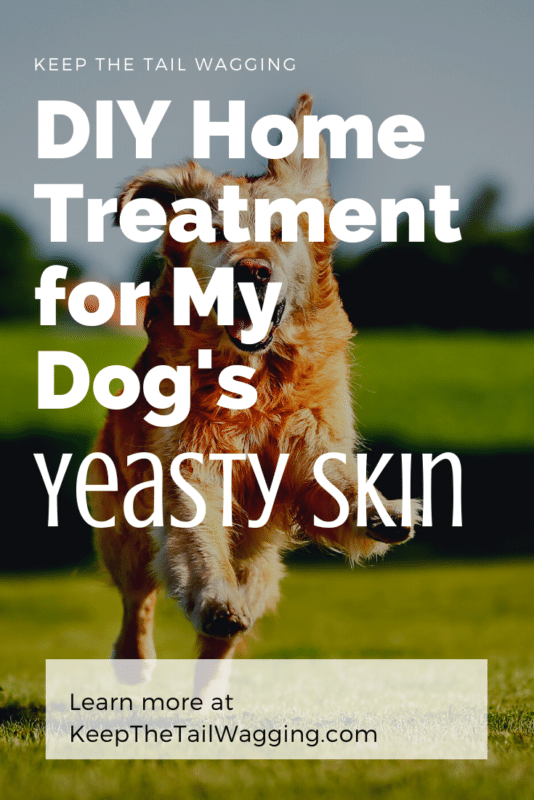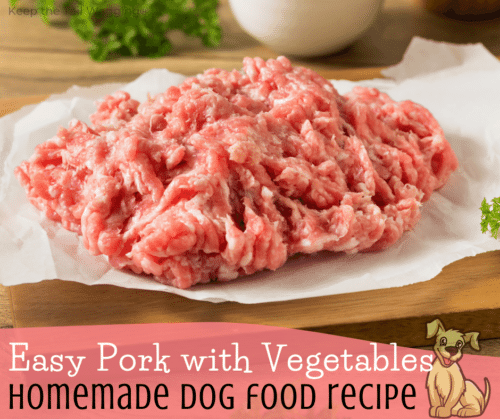Keep the Tail Wagging is supported by pet parents. I occasionally earn a commission (at no additional cost to you) when you click through an affiliate link to one of my favorite products. Thank you for your support. Read More
Years ago, one of our dogs, Sydney, had recurring yeast issues that presented in her ears, on her tummy, armpits, and groin area that I called “yeasty skin.” I got tired to repeat visits to the veterinarian that didn't resolve anything and chose to treat this at home. And it worked.
Please note that I am not a veterinarian.
What is Yeasty Skin in Dogs
I call it yeasty skin because the skin has a musty smell. Some people assume that it's a yeast infection. I honestly don't know. I tend to lean away from this diagnosis with my dogs because I didn't need antibiotics to treat the areas.
When my dog had yeasty skin, we noticed the following:
- the skin gets a dry, thick and greasy look to it
- the pigment (color) of her skin became darker
- the skin has a yeasty (musty) smell
- my dog would be scooting and licking the areas
- the skin would be red and irritated; her grown area would be swollen and the constant scooting broke the skin, so there would be blood droplets too
How I Treated My Dog's Yeasty Skin
Since going to the vet didn't work, I treated her skin first by cleaning all of the areas with a mixture of apple cider vinegar and water. And, before bedtime, I'd lightly massage the areas with coconut oil.
- Apple Cider Vinegar – a 50/50 blend of apple cider vinegar and filtered water is great to wipe on any areas with a yeast problem. I used a soft tissue to avoid further irritating the areas.
- Coconut Oil – coconut oil is a natural antibacterial, antifungal, and antiviral. After the skin dries, usually before I go to bed, I massage coconut oil in the area.
Treating My Dog's Yeasty Ears
I treated my dogs ears every evening for seven days by…
- misting them with the apple cider vinegar/water blend (I added it to a small spray bottle)
- gently wiping/cleaning the ears with a soft tissue
- allowing the ears to dry completely
- massaging coconut oil into the ears
I found that when I did this for fewer than seven days, the yeast returned. Somehow, a week was the magic number.
Treating My Dog's Yeasty Skin
For the skin, I did the same as with the ears. I cleaned the area with the ACV/water mixture, using a soft tissue. Then I massaged the areas with coconut oil.
I did this in the evening after we had all settled down because I was concerned that if my dog went outside, they would wipe away my home remedy as they walked and rolled in the grass.
Why My Dog Developed Yeasty Skin
Dogs will develop yeasty skin for a number of reasons. For some dogs, it's genetic, for others, it's bad diet or environment. For my dog, I think she developed yeasty skin because…
- She was over weight – Sydney was at least ten pounds overweight during this period due to injuries and inability to exercise. That extra weight creates deep skin folds that are a haven for yeast growth. She eventually shed the pounds when I began walking at her pace slowly, increasing the distance over time.
- Time of the year – during the spring and fall, when the Pacific Northwest experiences the bulk of our wet weather, my dogs are sitting and urinating on wet grass daily and I wonder if this was a contributing factor. I never had her tested for sensitivities, but she may have had an issue with wet grass (like her brother).
- Diet and unhealthy gut – although I was feeding my dogs a raw food diet when this was happening, I still had a lot to learn and needed to undo the damage of annual vaccinations, repeated antibiotics, and a processed diet. Focusing on improving my dogs' gut health through supplementation or whole foods (kefir, raw goat's milk, homemade yogurt, fermented fish stock, and vegetables) helped to boost the gut health and, in turn, improve the immune system.
Hypothyroidism in Dogs
If this sounds familiar, you can try what we do, but you should also know that constant yeast infections (in paws and ears too) can also be a sign of hypothyroidism.
Symptoms of hypothyroidism in dogs include:
- thinning hair in the trunk and haunches
- dry, flaky skin (but not itchy)
- black patches of skin
- weight gain
- sluggishness
- a difficulty with cold temperatures
- ear and nail infections
It's common for medium to large dogs between the age of 4-10 and is treatable. See your veterinarian about tests if you're concerned.
We had Sydney tested a couple of times and she was clear.
How Long to Clear Up Yeasty Skin
The yeasty skin cleared up quickly – within 72 hours. The first time I did the above treatment, I stopped once the yeasty skin went away – it returned. The last time I did this treatment, I continued for seven days and doing this, along with focusing on Sydney's gut health, cleared it up permanently.
My dog's yeasty skin never bothered her again. Sydney crossed the Rainbow Bridge in 2020 at the age of ten.
DIY Yeasty Skin Spray for Dogs
There are two things that you can mix into a spray bottle that will help clear yeasty skin:
My Original Recipe:
- Apple Cider Vinegar: 1/2 cup
- Distilled Water: 1 cup
- Apply to clean skin and coat, massage, rinse, and pat dry.
Rodney Habib's Recipe:
Rodney shared this on social media years ago through his Planet Paws page and I never forgot.
- Apple Cider Vinegar: 1/2 cup
- Brewed Green Tea (cooled): 1/2 cup
- Distilled Water: 1 cup
- Apply to clean skin and coat, massage, rinse, and pat dry.
This won't work for every yeast issue. If I were to adopt a dog tomorrow that had the same issues, I'd start by changing them to a fresh food diet and use the above treatment giving the new diet time to adjust the dog's system. If you've tried these things – then I highly recommend working with a holistic vet. If you can find one that also practices Traditional Chinese Medicine – even better (in my experience).
And, if you like reading, a great book to help dogs with these issues is Yin & Yang Nutrition for Dogs: Maximizing Health with Whole Foods, Not Drugs.

















